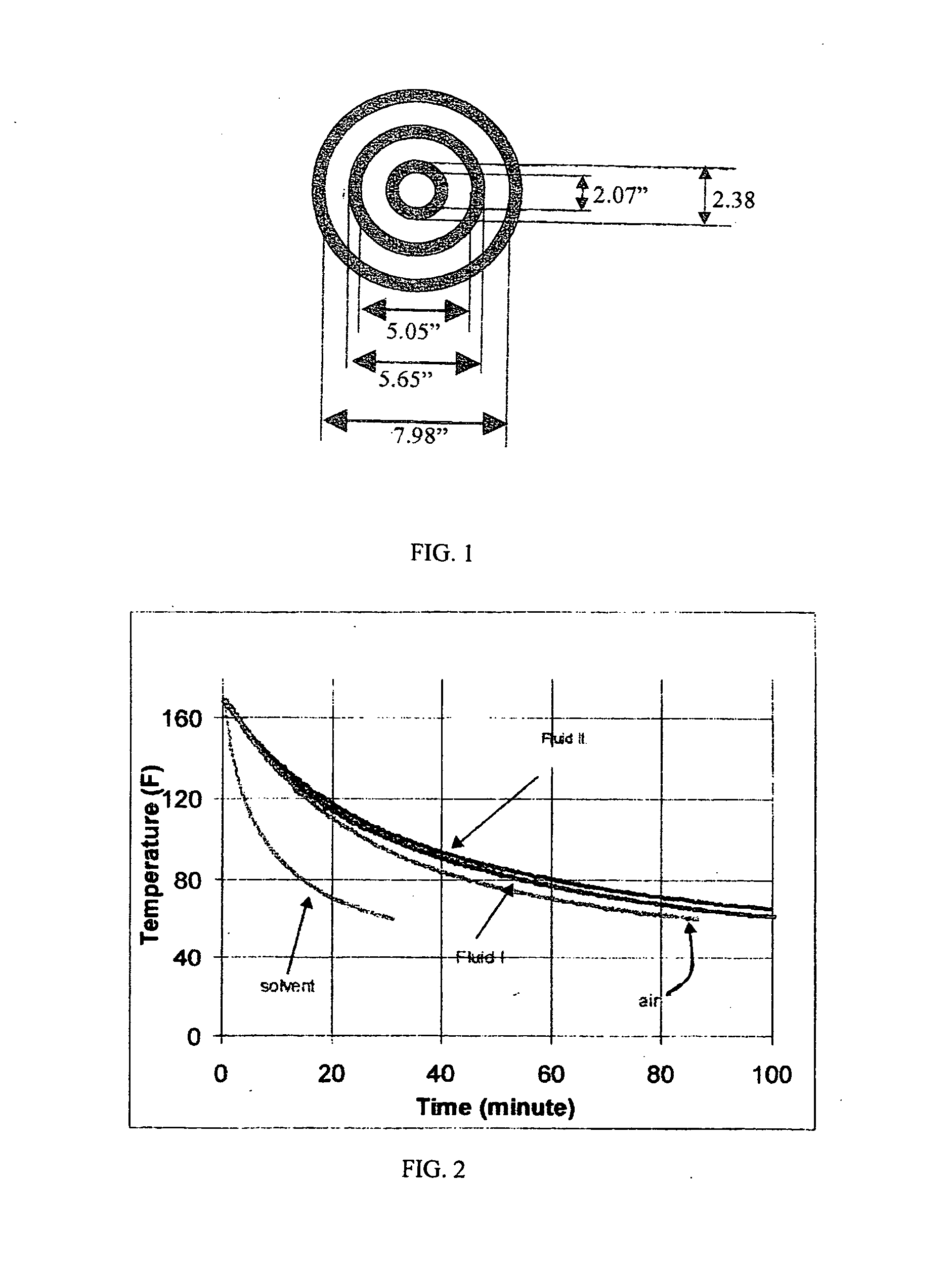Thermal insulation compositions containing organic solvent and gelling agent and methods of using the same
a technology of organic solvent and composition, which is applied in the direction of insulation, sealing/packing, and wellbore/well accessories, can solve the problems of uncontrolled heat transfer to outer annuli, destabilizing permafrost, and unsatisfactory heat loss from production tubing, so as to reduce convection flow velocity, reduce shear rate range, and high viscosity
- Summary
- Abstract
- Description
- Claims
- Application Information
AI Technical Summary
Benefits of technology
Problems solved by technology
Method used
Image
Examples
example 1
[0050] Example 1 examines the rheology of insulating fluids of the invention. 4 g of HE-100 was added to 350 mls of propylene glycol while stirring. After hydrating the mixture by mechanical stirring for 30 minutes and adjusting the pH above 10.0 with K2CO3, a 50 ml sample of the hydrated fluid was placed into a Fann 50° C. viscometer cup. The cup was then placed on a Fann 50° C. viscometer and pressured to about 300 psi (14 kg / cm2) with nitrogen. The sample was then sheared at 100 sec−1 for 28 minutes at 120° F., followed by a rate sweep using 100, 75, 50, and 25 sec−1 for about 2 minutes. The oil bath temperature was pre-set to 49° C. and the bath was raised to submerge the sample cup. The rate sweep was repeated every 28 minutes, and the interim rate between sweeps was 100 sec−1. The stresses associated to each rate used in the sweep together with the rates were used to calculate the power law indices n and K; wherein n refers to flow behavior index and K refers to consistency in...
example 2
[0054] Example 2 examines the thermal insulation effectiveness of certain fluids using a laboratory-sized heat transfer apparatus.
[0055] Two fluids were prepared in accordance with the procedure of Example 1 but using 4 lbs / barrel GM-60 and 4 lbs / barrel HE-100. The thermal insulating properties of thermal insulating fluids were evaluated in a laboratory-sized heat transfer apparatus to determine the thermal effectiveness of the fluids. These fluids were contrasted with pure solvent and ABIF. The heat transfer apparatus consisted of three concentric aluminum pipes connected and sealed by two flanges. The physical dimensions are shown in FIG. 1. Hot fluid at constant temperature was circulated in the inner pipe, while cold fluid at constant temperature was circulated in the outer annulus. The test insulating-fluid was contained in the annulus between the hot and cold reference fluids. The top and bottom of the apparatus were insulated to assure that heat flow was in the radial direct...
example 3
[0059] Example 3 illustrates the effect of propylene glycol concentrations on the insulating behavior of the insulating fluids. 91.4 g of a specialized hydroxypropyl guar, commercially available as GM-60 from BJ Services Company, was added to 8,000 mls. of a mixture of propylene glycol and sodium bromide brine (density of 1.5g / ml) in different ratios under rapid agitation. After hydrating the mixture using a mechanical stirrer for 30 minutes and adjusting the pH in excess of 10.0 with K2CO3, the prepared thermal insulating fluids were transferred in a laboratory-sized heat transfer apparatus as described in Example 2 to determine the thermal insulating effectiveness of the fluids.
[0060] During the test, hot water and cold water temperatures were set at 180° F. and 50° F., respectively. After thermal equilibrium was achieved (2 to 3 hours) for a given test, data was collected to calculate heat transfer coefficient and apparent thermal conductivity and summarized in Table IV:
TABLE ...
PUM
| Property | Measurement | Unit |
|---|---|---|
| Percent by mass | aaaaa | aaaaa |
| Percent by volume | aaaaa | aaaaa |
| Frequency | aaaaa | aaaaa |
Abstract
Description
Claims
Application Information
 Login to View More
Login to View More - R&D
- Intellectual Property
- Life Sciences
- Materials
- Tech Scout
- Unparalleled Data Quality
- Higher Quality Content
- 60% Fewer Hallucinations
Browse by: Latest US Patents, China's latest patents, Technical Efficacy Thesaurus, Application Domain, Technology Topic, Popular Technical Reports.
© 2025 PatSnap. All rights reserved.Legal|Privacy policy|Modern Slavery Act Transparency Statement|Sitemap|About US| Contact US: help@patsnap.com

